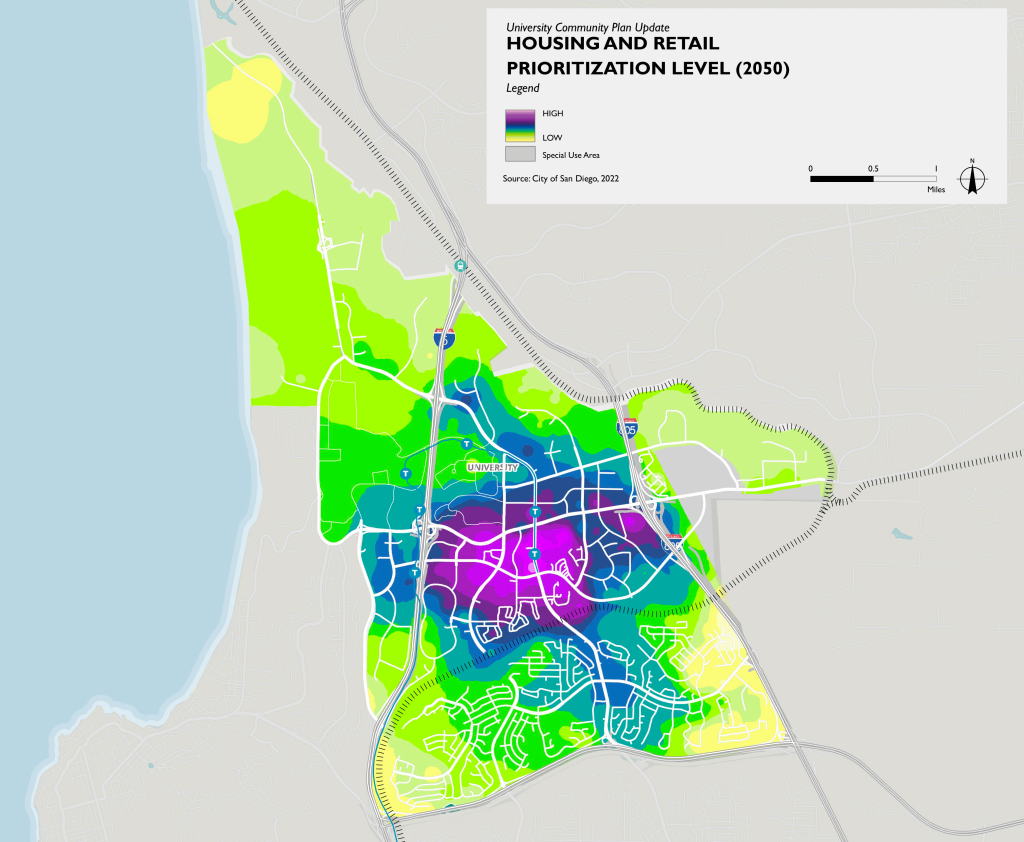
Reacting to the City’s longstanding proposal to substantially increase density in part of University City, opponents claim they’re being ignored by the City while insisting that densification is an overreaction to mandated affordable housing.
The City has said it is seeking higher density in UC to significantly shorten the commute time for thousands of people working but not living there.
Recently, the City released the latest draft update to the University Community Plan. That update would allow some of the highest-density housing in San Diego other than downtown. Most new housing would be centered in UC around the six Blue Line Trolley stations that were activated in November 2021.
The City also recently released a draft environmental impact report for the proposed zoning changes, which concluded the highest-density option for UC was the “environmentally superior alternative,” because that option reduces average commute distances while allowing more people to live within walking distance from the trolley.
University City in the northwestern portion of the City next to the UC San Diego, was originally intended to serve as housing for university faculty, hence its name. Bordered by La Jolla and Interstate 5 to the west, Miramar and Interstate 805 to the east, and North Clairemont and Highway 52 to the south, UC has a triangular-shaped boundary, with the northern half of UC hosting University Towne Centre (UTC) mall.
A couple of UC resident groups, Help Save UC and UC Neighbors for Responsible Growth, otherwise known as “UC PEEPS,” have emerged claiming the City’s plans for densification would add 35,000 to 56,000 housing units to University City by 2050. Such a change, some insist, will be a community character buster fundamentally altering the existing neighborhood and further stressing already overburdened infrastructure.
Following are excerpts from a letter from UC residents opposed to further densification sent recently to Mayor Todd Gloria and the City: “Adding between 30,000 and 33,000 housing units, or as many as 56,000 housing units as pro-development groups are calling for, represents exceptionally poor planning, especially when you consider our small 7.35-square-mile footprint and the limited capacity of our existing infrastructure. We know San Diego needs more affordable housing. But we need a reasonable increase in new housing units in UC. What the City is proposing for UC is far beyond the number of new housing units that are needed. There is absolutely no call for placing more.
“The City plans to add tens of thousands of people, without regard to the existing, limited infrastructure,” continues the UC letter. “There are no provisions to add new roadways, schools, parks, recreational facilities, libraries, fire and safety facilities and water and sewer systems. There’s no money to fund new infrastructure, and there’s no undeveloped land left here to add them.”
Bonnie Kutch, spokesperson for UC PEEPS, addressed issues some UC community members are unhappy with in terms of the City’s aggressive stance promoting greater densification.
“Despite five long years of community engagement involving thousands of hours of meetings, the City has chosen to ignore UC residents’ reasonable requests and recommendations and, instead, come back with the egregious high-density plan they’ve had in mind for us all along,” Kutch said.
She added: “The City’s version of the UC Plan Update was cooked up behind closed doors for a private party of four: Developers, labor unions, UCSD, and Mayor Gloria. The City’s revised plan would more than double, possibly triple, the population of University City without adding the infrastructure needed to support such a gigantic population increase.”
Responding to the City’s draft EIR on UC’s proposed densification, Kutch noted: “The statement that the ‘higher density scenario is better for the environment,’ is entirely implausible. Adding 65,000 or more people to UC most certainly will have tremendous environmental impacts.”
Noting UC PEEPs has engaged an attorney to analyze the City’s draft EIR, Kutch said that analysis finds higher density would promote a “more energy-efficient land-use pattern, without considering the overall impact of requiring more energy to support an additional 65,000 or more people; it doesn’t consider additional greenhouse gas emissions from 65,000-plus people; and the City hasn’t done a complete traffic analysis in UC since 2015. If they were to do so now at peak traffic times, particularly when all four schools along Governor Drive let out, they would know there is complete traffic gridlock, with residents living on nearby streets unable to even leave their homes.













Discussion about this post